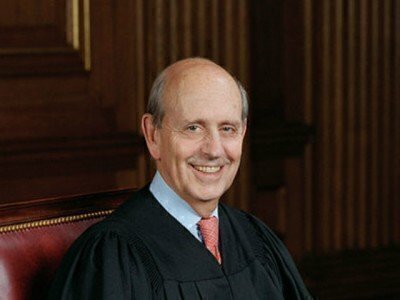On August 3, 1994, Stephen Breyer was sworn in as the 108th Justice to serve on the Supreme Court. His path to the nation’s highest court included stops at Harvard, the federal court system, and a brief stint as a Watergate counsel.
 Breyer was 55 years old at the time of his confirmation and viewed as a centrist federal appeals court judge.
Breyer was 55 years old at the time of his confirmation and viewed as a centrist federal appeals court judge.
News broke in May 1994 that Breyer would be President Bill Clinton’s second – and last – Supreme Court nomination. A year earlier, Breyer had been a finalist for the nomination that went to Ruth Bader Ginsburg.
Clinton had reportedly considered three people to replace the retiring Harry Blackmun: Breyer, Interior Secretary Bruce Babbitt and Arkansas federal judge Richard Arnold.
The New York Times reported that Breyer was known as a “builder and a pragmatist whose court rarely produces a dissenting opinion. He already has bipartisan support in the Senate, where he worked as an aide during the 1970s and helped build coalitions across party lines to deregulate the airlines.”
Babbitt was reportedly Clinton’s first choice, but he also faced a Senate confirmation fight. In comparison, Breyer was well-known and respected for this work with the Senate before accepting a federal court appointment in 1980.
Breyer was born in California, attended Stanford University, Harvard University, and Oxford University, and he taught at Harvard. Breyer also clerked for Supreme Court Justice Arthur Goldberg in his first year after law school.
After joining Harvard’s faculty in 1967, Breyer served as Assistant Special Prosecutor of the Watergate Special Prosecution Force in 1973, where he worked with Archibald Cox. Breyer left that position to become a counsel, and then chief counsel, to the Senate Judiciary Committee. His work on airline deregulation drew praise from Republicans and Democrats.
President Jimmy Carter appointed Breyer to the First Circuit Court Of Appeals in 1980, after Breyer reportedly declined an opportunity to become the dean of Harvard’s Law School. In 1990, Breyer was named Chief Judge of the First Circuit Appeals Court.
During the drama over Clinton’s first Supreme Court nomination in 1993, Breyer met with Clinton despite serious injuries Breyer had received in a bicycle accident. The reportedly chaotic 1993 nomination process included Mario Cuomo and First Lady Hillary Clinton as potential nominees to replace Justice Byron White. President Clinton chose Ginsburg as his first appointment.
In 1994, Blackmun announced his retirement in April and the White House took five weeks to consider his replacement. President Clinton made the decision quickly to nominate Breyer, calling him 30 minutes before the public announcement – and not giving Breyer enough time to make it to a public ceremony.
Breyer was confirmed after a week of hearings in the Senate by an 87-9 vote on July 29, 1994. "The responsibility of that position is awesome, rather humbling," Breyer said at an appearance with President Clinton after his confirmation. "I'll do my best."
Among Breyer’s supporters was Republican Strom Thurmond. "Judge Breyer does not seem to have an ideological bent to move the court in one direction or another," the conservative Senator said during the nomination process.







